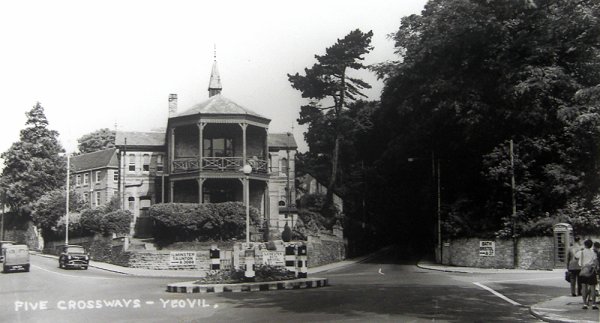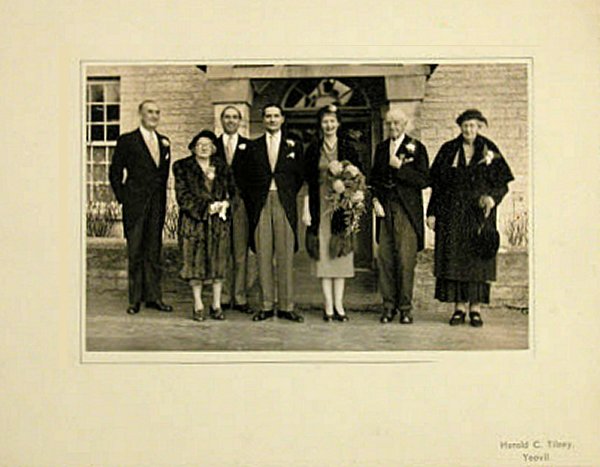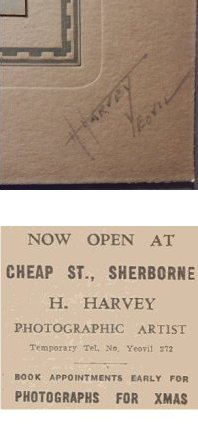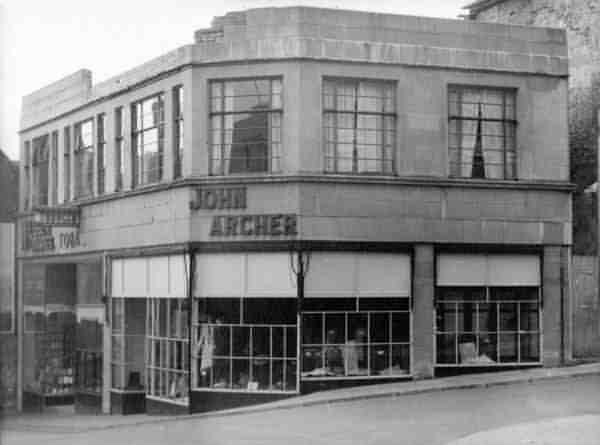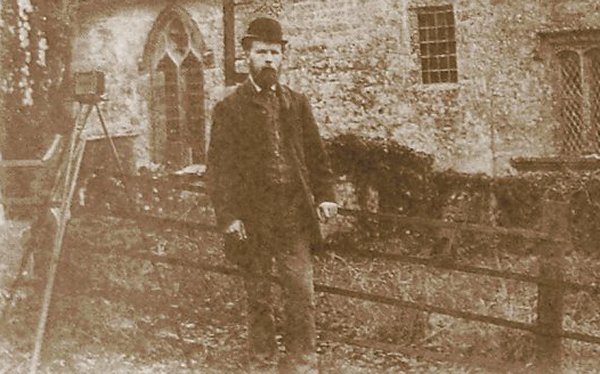yeovil trades & traders
Yeovil's Photographers
The Victorian craze comes to Yeovil
-
Introduction
-
Visiting Professional Photographers
-
John Eastham (from Taunton)
-
Henry & Jonas Walter (from London)
-
Yeovil's Professional Photographers
-
Yeovil's Amateur Photographers
![]()
Introduction
The 1850s saw the introduction of the photographic studio in England, when the new 'science' of photography meant that a 'likeness' became affordable for the masses. As with other towns, Yeovil saw its fair share of photographic artists setting up studios and this page is a synopsis of the known early photographers in Yeovil, many of whom have their own pages on this website.
Initially, in the 1850s, temporary photographic studios would be set up in shops in the town by visiting professional photographers and several are noted below.

An advertisement for a temporary photographic studio for an un-named photographer from the Sherborne Mercury's edition of 26 August 1856.
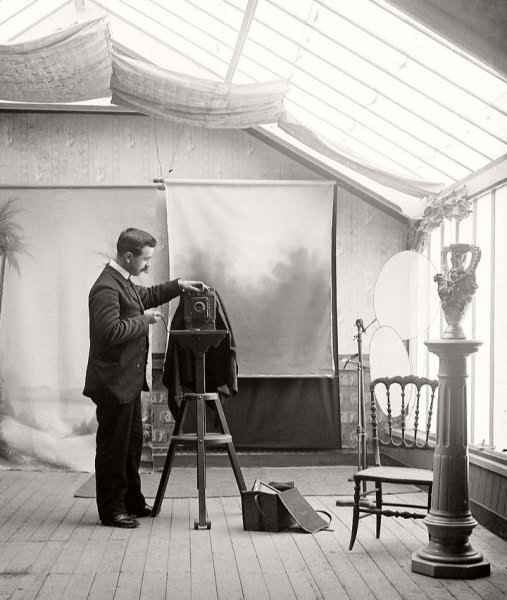
Many advertisements by photographers refer to a 'glass chamber' - this was simply a photographic studio with as much natural light as possible, gained by having large windows and a glazed roof, as here. Note the two reflectors at right
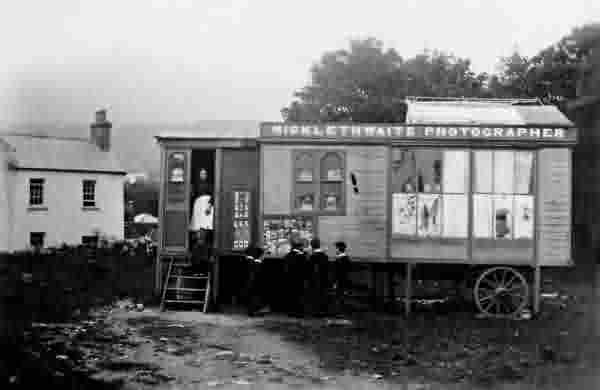
Later, mobile photographic studios and darkrooms appeared. It was likely that various photographers, such as Adam Gosney, who set up various studios in various towns and villages, would have used a similar portable set-up.
Notes on Cartes de Visite and Cabinet Cards
Cartes de visite were introduced in Britain in 1859 and became a relatively cheap way for almost anyone to have their photograph taken. Cartes de visite (also known as cartes or CDVs), are small paper-on-card photographs. They typically measure 4" x 2½" (102mm x 62mm) and the photograph which was pasted on to the card was roughly cut to about 3½" x 2¼" (90mm x 57mm). They were never actually used as visiting cards. For one of the very earliest of Yeovil's CDVs, see John Swatridge below.
Cabinet cards were introduced in 1866 but did not really become popular until the late 1880s and 1890s. Cabinet cards were the larger version of the carte de visite and customers were often sold the same photo in both sizes. Cabinet cards measure 16.5 x 10.5cm and usually have the studio name and address printed at the bottom. The cabinet card persisted until about 1910 by which time it had been replaced by the much cheaper postcard format.
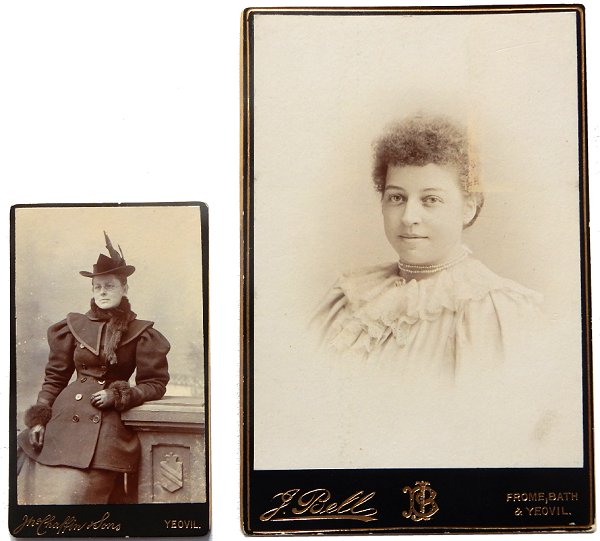
Both from my
collection
At left is a carte de visite by John Chaffin & Sons, at right a cabinet card by John Bell, both date to the 1890s and are reproduced here about actual size.
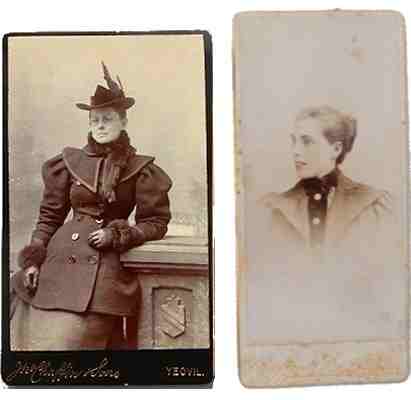 For
completeness, at
left is the same
CDV alongside
what is known as
a micro cdv from
my collection.
For
completeness, at
left is the same
CDV alongside
what is known as
a micro cdv from
my collection.
This micro CDV was produced by John Chaffin's cousin, William Chaffin of Sherborne. It measures 4½" x 2" (112mm x 50mm).
As far as I'm aware, the micro CDV format was rarely, if ever, used by any Yeovil photographers.
A Note on Multi-Image Cameras
The great populariser of the carte de visite was André Disdéri, who in 1854 was granted patent for a means whereby several smaller images could be exposed on to a single 10in x 8in plate, thus reducing overall processing costs.
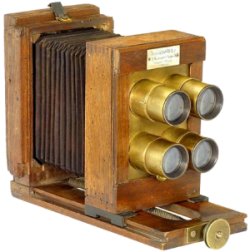 The
camera Disdéri
first used was
one invented by
Antoine Claudet,
and shown by him
at the Great
Exhibition in
1851. Claudet’s
instrument, the
‘multiplying
camera-obscura’,
had a plate
holder "Which
could be
mechanically
moved both
across and down
to allow
different areas
of the emulsion
to be covered by
successive
exposures
through the same
lens, to
represent on the
same surface a
number of
different
pictures, or the
same in various
aspects, the
portraits of
several persons,
etc."
The
camera Disdéri
first used was
one invented by
Antoine Claudet,
and shown by him
at the Great
Exhibition in
1851. Claudet’s
instrument, the
‘multiplying
camera-obscura’,
had a plate
holder "Which
could be
mechanically
moved both
across and down
to allow
different areas
of the emulsion
to be covered by
successive
exposures
through the same
lens, to
represent on the
same surface a
number of
different
pictures, or the
same in various
aspects, the
portraits of
several persons,
etc."
Later cameras adopted by carte de visite photographers included those with four independent lenses as seen here which, working with a simple shift mechanism, could double up to take the usual set of eight images on the one plate.
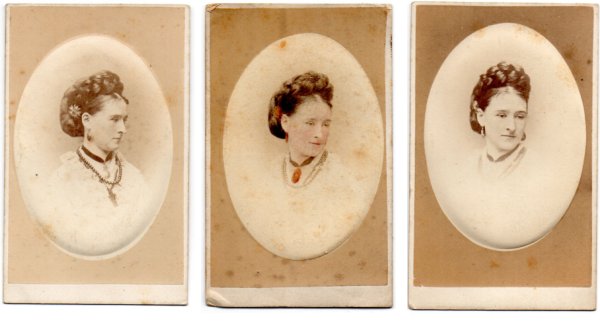
From my
collection
Three portraits of 'Aunt Minnie' by John Chaffin & Son. From the back design these all date to around 1870. Whether or not these were taken on a multi-image camera or not is all but impossible to tell (assuming the fourth photo is now missing). There are clearly three different poses all taken in the same session, but the processing treatment is different in each case. All three cartes have a central oval 'cushion' in which the portrait is made to stand out in three dimensions by shaping a raised portion. The oval framing of the photograph and the 3D cushion effect were a more expensive 'deluxe' option.
In the carte at left, Minnie's full panoply of necklaces are displayed. The centre carte has been slightly colourised by applying pale pink to her flesh and applying gold paint to her hair-ornament and necklace pendant while the number of necklaces has been reduced in the darkroom. At right, the necklaces and pendant are completely removed in processing leaving just the ribbon of the pendant.
A Note on CDV and Cabinet Card Backs
The printed backs of CDVs are among the best ways of dating them and the images of backs in the following section have been of great help in dating Chaffin's output.
Initially, as seen from the first example below, the photographer would have bought square-cornered CDV blanks from a local supplier, usually a printer, and simply wrote his name on the back. Photographers began to have their name printed on the CDV back in a very simple way, probably pushed into it by the printer who was not getting any work out of this - a simple print did not add much to the cost of the card. Soon, what was written on the back of the carte became a status symbol between local photographers competing for customers.
Very quickly card stock with decorative standard printed backs became available from larger printing houses (see second example below). The only way to get prices down to below the level of the customer's local printer, would be by economies of scale - that is, print a lot of the same design and try to sell them to everyone - this they tried to do using muted colour cards with a simple border as the second example.
Around 1863-4 A Marion & Co of Soho Square, London, was established. By 1866 Marion was employed handling the wholesale publishing of the sale of 'famous people' carte de visites, for the top London studio of Mayall. By 1870 Marion were making the backs for sale to photographers, and had travelling salesmen promoting their product to the smaller studios using a standard catalogue of designs. It is therefore not uncommon to come across the same basic imagery employed on the carte backs of quite different establishments. The designs were created, of course, not by the photographers but by commercial printers, who had access to ready-drawn imagery in the form of stock lithographic transfers.
The design of carte backs became increasingly elaborate throughout the next few decades, although by the turn of the century backs tended to become plain once again.
As an example of the cost of a photograph - the visit to the photographer's studio was generally free and the following list of prices, from John Bell of Hendford in 1896, are typical -
- Cartes de visite - 12 copies from 7 shillings (about £35 at today's value)
- Cartes de visite - 6 copies from 4 shillings
- Cartes de visite - 3 copies from 2s 6d
- Re-orders - 6d each, any number
- Cabinet Cards - 12 copies from 12 shillings
- Cabinet Cards - 6 copies from 7s 6d
- Cabinet Cards - 3 copies from 4s 6d
- Re-orders - 1s each, any number
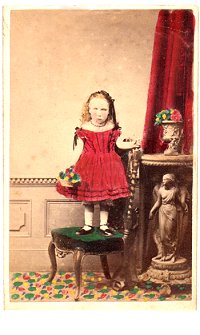 Many of the
early
photographers
had originally
trained as
artists and a
frequently-offered
service was to
provide a
coloured version
of the
photograph.
Many of the
early
photographers
had originally
trained as
artists and a
frequently-offered
service was to
provide a
coloured version
of the
photograph.
This was often achieved by creating a portrait in oils, or other medium, as a direct copy of a photograph. Alternatively, as in this example at left (not a Yeovil photographer) from my collection, by painting directly onto the photograph.
For example, John Chaffin of Hendford, employed his three daughters as artists to create lifelike portraits in oil paints or to colour monochrome prints. Louisa at the Hendford studio and at Taunton by her elder sisters Kate and Maria, who had earlier been listed as artists.
Visiting Professional Photographers
Thomas SharpThomas Sharp (1806-1896) 'of London' (see advertisement below) is thought to have been the first professional photographer to visit Yeovil with a temporary photographic studio set up in Reckleford (today's Market Street) for a short six-month season in 1847. Thomas Sharp was born in Cheapside, London, on 18 August 1806 and baptised on 15 February 1807 at St Lawrence Jewry & St Mary Magdalene, Milk Street, London. A very early pioneer of photography, he purchased a licence permitting him to take daguerreotype portraits in parts of Somerset and established the first photographic studio in Bath by November 1841. Leaving Bath in 1843, he went to London to work with either Beard or Claudet. By 1846, again working independently, he set up a portable photographic studio at Weston-super-Mare. In 1847 he had a brief sojourn in Yeovil, he travelled throughout the West Country setting up short-term studios, variously in Torquay, Exmouth, Weymouth and Dorchester. He sold his portable studio in 1853. The only references to him in Yeovil are from the Western Flying Post reproduced here.
|
|
|
John EasthamJohn Eastham was born around 1821 at Samlesbury, near Blackburn, Lancashire. He was initially a book-keeper in Blackburn but then traded as a coal merchant. Selling the coal business, he set up as a photographic artist, possibly in conjunction with his younger brother Silas who had a daguerreotype business in Preston, Lancashire. John worked as a photographer travelling to Bradford in 1849, Worcester in 1851 (where he was assisted by his youngest brother Enos). He then travelled to Malvern and then Taunton in 1852. He returned to Taunton in 1853, staying at 2 Hammet Street. He was possibly the second professional photographer to visit Yeovil, with a temporary photographic studio set up in Raymond's gent's outfitters in Middle Street. The only references to him in Yeovil are from the Western Gazette's edition of 5 April 1853 and the 12 April 1853 edition of the Sherborne Mercury reproduced here.
Advertisement from the Western Gazette's edition of 5 April 1853.
Advertisement from the Sherborne Mercury's edition of 12 April 1853.
|
|
|
John Shattock CliftJohn Shattock Clift was another professional photographer to visit Yeovil. John Shattock Clift was born in Spaxton, Somerset, in 1820. He was the third of the five children of labourer George Spaxton (1791-1879) and Sarah née Dibble (1791-1869). John was baptised at Spaxton on 20 March 1820. In the 1851 census he was listed in Bridge Street, Taunton, and gave his occupation as a master confectioner. In 1855 he visited Yeovil for a brief period with a temporary photographic studio set up in Mrs Cox's premises in South Street. By the time of the 1861 census he was lodging at 12 Boyces Street, Brighton, where he gave his occupation as an 'Artist in Photography'. He was listed as a photographer at Cherry Grove, Rowbarton, Taunton, in 1871 but by 1881, 61-year old Clift was working as a botanical compounder at 53 Glatney Esplanade, St Peter Port, Guernsey. The only reference to him in Yeovil is from the Western Flying Post of 24 July 1855 reproduced here.
|
|
|
Philip MonsonPhilip Monson was another visiting professional photographer in Yeovil with a photographic studio in Princes Street during the mid-1850s. Philip Monson was born on 6 June 1828 in Colchester, Essex, the son of gardener James and Susannah Munson. He was baptised on 12 April 1829 at the Lion Walk Meeting House (Independent), Colchester. In the 1851 census Monson was recorded as an artist portrait painter at 5 Chapel Terrace, Wolverhampton. Philip had three brothers, Edward (b1822), Benjamin (b1824) and Charles (b1830). All four brothers would eventually be connected with photography. Early in 1855 Philip was practising on his own in Bedford, where he was using a camera capable of producing large format daguerreotypes. Later in 1855 he went to Reading and Winchester and in 1856 he is known to have worked in Salisbury and Yeovil. The advertisement below is from the Western Gazette's edition of 26 August 1856. Monson left Yeovil in late October 1856, emigrating to Canada around 1859-60.
|
|
|
Mr M BrownMr M Brown was another professional photographer to visit Yeovil with a temporary photographic studio set up in Perry's Hotel in South Street during the spring of 1856. Mr Perry was, in fact, John Perry the technical blacksmith and temperance hotelier photographed around 1858 by John Swatridge (see below). By August 1856 Brown had removed to Newton Abbot where he set up a photographic studio in Station Road. Philip Pethick Perry (see below), the son of John Perry, was trained by Brown during his visit to Yeovil and took over the photographic portrait rooms at his father's hotel when vacated by Brown.
This advertisement was placed in the Western Flying Post from April to June 1856.
At the end of his three-month Yeovil sojourn, Mr Brown and Philip Perry (see below) placed this joint advertisement in the 8 July 1856 edition of the Western Flying Press.
|
|
|
Henry & Jonas WalterProbably among the last of the visiting professional photographers since by now there were several locally established photographers, H&J Walter of Oxford Street, London, visited Yeovil with a temporary photographic studio in Mrs Hand's premises in Silver Street - the advertisement below is from the 26 June 1860 edition of the Western Flying Post. Mrs Hand was the widow of artist and photographer George Monck Hand. Henry Walter was born in Hull, Yorkshire, in 1815 and his brother Jonas was born in Hull in 1818. Both brothers remained bachelors. In the 1851 census both brothers were lodging at the Fountain Inn, Southgate, Chichester and both gave their occupations as 'Artist and Profile Taker'. Their advertisement for their 1860 visit to Yeovil gave their London studio address as 538 Oxford Street, London,
|
Yeovil's Professional Photographers
John & Thomas Swatridge
It is probable that John Swatridge (1810-c1860s) and/or his son Thomas Sydenham Swatridge (1841-1909) were the first professional Yeovil photographers. John Swatridge was a marble carver and gilder by trade and photography appears to have been a sideline although he is known to have had a photographic studio. His son, Thomas also became a professional photographer and eventually ran two photographic studios in London.
One of the earliest of John Swatridge's cartes de visite, judging by the lady's costume, the lack of background or props, and the early style of the back, it dates to around 1859 - the year cartes de visite were first introduced into England. Indeed, this is one of the very first cartes de visite to have appeared in Yeovil.
A carte de visite by Thomas Swatridge, with his own logo, dating to around 1860 when the full bell-shaped crinoline was beginning to flatten at the front. The lady's hair style of centre parting and ringlets at the rear is typical of this date. At this time, Thomas Swatridge was just eighteen years old and would leave Yeovil two years later. For John & Thomas Swatridge's webpage - click here.
|
|
|
Philip Pethick PerryMr M Brown (see above) was a professional photographer who visited Yeovil with a temporary photographic studio set up in Perry's Temperance Hotel in South Street during the summer of 1856. By August 1856 Brown had left Yeovil, although during his sojourn in Yeovil he had trained John Perry's son, Philip, in the art of photography. Philip Pethick Perry, born in 1837 in Sherborne, Dorset, was the son of technical blacksmith and temperance hotelier John Perry mentioned above. By trade Philip was a blacksmith like his father. Nevertheless, as seen from the advertisement below, after Brown had left Philip Perry advertised himself as a photographer at his father's hotel. By 1861 however, (and possibly as early as 1857) Philip was boarding at 23 Oxford Street, Swindon, and was working as an engine fitter. By 1881 he was working as a surveyor in Fulham, London. He died on 5 September 1903 in a nursing home at Harrogate, Yorkshire. None of Philip's photographic work is known.
This advertisement was placed in the Western Flying Press's edition of 12 August 1856.
This advertisement was placed in the Western Flying Press's edition of 19 May 1857. The fact that the advertisement does not mention young Perry is, perhaps, an indication that he had left Yeovil by this time?
This photograph of South Street was taken around the 1890's and shows the Globe and Crown at left, opposite is the Greyhound Hotel and next door to that was the Cow Inn. Just visible at the end of the street is the Three Choughs Hotel and the King's Arms. Between the Choughs and the Cow was the Market House Inn and three un-named beerhouses. Despite the huge number of pubs in this short run of South Street, the white building with the black porch left of centre was John Perry's Temperance Hotel.
|
|
|
Henry Marsh Custard Jnr
One of the earliest of Yeovil's professional photographers was Henry Marsh Custard Jnr but it appears that he was only operating for a short period during 1856. Born in Yeovil on 8 August 1835 he was the son of Henry Marsh Custard, a bookseller, printer and stationer whose premises were on the corner of what is now Princes Street and Westminster Street. Henry Jnr clearly set up his photographic studio in his father's premises but this venture seems to have been only temporary. Henry Jnr became an artist and died in Rome on 12 April 1863 age 28.
Advertisement placed in the 1 July 1856 edition of the Western Flying Post.
Advertisement for Henry Custard Jnr's 'Photographic Institution' in the 2 December 1856 edition of the Western Flying Post. As a rough guide to costs at this time, five shillings would, at today's value, be equal to about £20 - so very early photography was not particularly cheap for the consumer.
This photograph, one half of a stereoscopic pair, was taken around 1870 and looks down Hendford with High Street at extreme left. At right is Stuckey's Bank, facing High Street, and next to it (by the lamp-post) was Henry's photographic studio and his 'Photographic Institution'.
The headstone inscription reads "To the memory of H Marsh Custard, British Artist of Yeovil Somerset England who died April 12th 1863 aged 28 years". The slab inscription reads "In sacred remembrance of Henry Marsh Custard of Yeovil Sumerset (sic) England. Born August 8th 1834 Died April 19th (sic) 1863. This tribute is placed to his beloved memory by his sorrowing Mary. Blessed are the dead which die in the Lord from henceforth; Yea, saith the spirit, that they may rest from their labours and their works do follow them".
|
|
|
George Bartlett Coggan
During the 1850s George became involved in the new art of photography but, once again, he seemed to move around a lot. He is known to have had a studio in Regent Street, London, before moving to Derby in 1857. It was probably around 1859 that he moved to Yeovil and set up a photographic studio - the carte de visite at left is dated 1862 - the period when he had studios at Yeovil and Shepton Mallet. Interesting that he describes himself on the reverse of the CDV as "Artist, Dentist, &c". For George Bartlett Coggan's webpage - click here
|
|
|
Barnet and Isaac GilesBarnet Giles was born in 1810 in Poland, most likely of Jewish descent. He married Ann (b1816, Poland) and their first child, John, was born in Poland in 1841. By 1844 the family had moved to England and in the 1851 census the family were living in Bridge Street, Wincanton. Barnet gave his occupation as a travelling tea dealer. By the 1861 census, Barnard gave his occupation as a jeweller and hawker, while his 14-year old son Isaac gave his occupation as a photographer. By August 1861 the family had moved to Yeovil and 'B Giles & Son' were placing weekly advertisements for his jewellery business in Princes Street which also boasted a photographic department. Undoubtedly Barnet ran the jewellery side of the business, while Isaac managed the photographic side of the business. By the beginning of 1867 Isaac had removed to Bristol, where he set up as a jeweller at Temple Street. This, presumably, ended the photographic side of the business of B Giles & Son. In 1869 Barnet was declared bankrupt and it was probably this event that caused him to leave Yeovil. None of their photographic work is known. For Barnet and Isaac Giles' webpage - click here
|
George Monck HandGeorge Monck Hand was born in Southwark, Surrey, on 26 June 1828, the son of John Hand (1780-c1828), Captain of Marines, and Sophia Anne née Tracy (b1789). On 2 September 1857, at St John's church, Yeovil, George "of Chatham" married Sarah Leigh Rendall, only daughter of Giles Rendall, confectioner of Silver Street, and his wife Melina. By the time of the marriage Giles Rendell was deceased and Melina was running the confectionery shop next door to the Half Moon Inn. It was in the confectionery shop that George Hand briefly set himself up as an artist and photographer. It appears that George split the confectionary shop into two separate premises. For his photographic studio, George erected a "large glass room attached to the premises". George Monck Hand died on 19 May 1860 in the Silver Street premises. He was aged just 31. The following month Sarah let out his studio to probably the last of the visiting professional photographers, H&J Walter of Oxford Street, London. The photographic studio was next briefly occupied by George Rawkins (see next). No examples of George Hand's photographic work have yet been discovered. For George Monck Hand's webpage - click here
|
|
|
Henry Goodfellow
He is known to have been in Yeovil working as a photographer from 1867 and placed several advertisements in the Western Gazette regarding his new studios in Kingston, next door to the Red Lion Inn. By 1871 he had moved to Brighton Place, Clevedon, again working as a photographer. He returned to Wincanton during the 1880s and died there in 1890 aged 80. For Henry Goodfellow's webpage - click here
|
|
|
Frederick Treble
|
||
|
|
Frederick Treble was born about 1832 in Paddington, London, the son of artist Benjamin Treble and his wife Eliza. In the 1841 the family were living in Finsbury. In 1856, in Coventry, Warwickshire, he married widow Elizabeth Wyndham, they were to have seven children. In 1857 he was made bankrupt. He moved briefly to Salisbury in 1858, but by 1859 he was living in Yeovil working as an artist with John Swatridge (see above). In the 1861 census, Frederick gave his occupation as 'Artist in Painting, Practising Photography'. The photograph above left is believed to be of Frederick Treble, taken at about the time he was in Yeovil. Little of his work is known. For Frederick Treble's webpage - click here |
|
|
|
||
|
|
||
John Chaffin (& Sons)
|
||
|
|
John Chaffin was one of the first in Yeovil to become involved in the newly developing technology of photography and in 1862 he established himself as a photographic artist with a studio at 6 Hendford (immediately next door to the Butcher's Arms). He was soon joined by his family and the 1871 census shows that John gave his occupation as a Photographer, as did sons Thomas and John, by now aged 21 and 17 respectively. Daughters Kate and Maria, aged 20 and 19, were both listed as Artists and were employed hand-tinting photographs and also producing portraits in oils from photographs. John Chaffin & Sons also opened a branch studio in Taunton. The firm was active until 1919. For John Chaffin & Sons webpage - click here.
|
|
|
|
||
James Ray FrancisThere is very little information regarding James Francis as a photographer in Yeovil. He was born in Faversham, Kent, in 1820 and in the 1861 census, while living in West Street, Havant, Hants, gave his occupation as a photographer. He then moved to Yeovil, and at the Colmer manslaughter trial in 1863 he gave evidence that he was an assistant photographer at the studio of John Swatridge. He was one of the first Yeovil photographers to be listed in a trade directory when the Post Office Directory listed him as a photographer of Princes Street in his own right in 1866 although, of course, others had been operating as professional photographers in the town for years. This is the only reference to him in a Yeovil trade directory. By 1871 he was working as a photographer in Godalming, Surrey. He died in Horsham, Sussex, in 1907 aged 87. No examples of his photographic work have been found.
|
|
|
William Thomas Paine SuggWilliam Thomas Paine Sugg was born during the autumn of 1843 and variously recorded as St Sitwells, Exeter and Exmouth. He was the third of the five sons of reading and billiards room keeper James Sugg (b1819) and Ann née Williams (b1819). Around 1867, William moved to Yeovil. He worked for stone mason and carver John Swatridge (see above) of Princes Street, who also ran a photographic studio. It appears that William ran the studio and was probably the actual photographer who worked under Swatridge's name. Having worked for John Swatridge for five years, in 1872 William Sugg and John Swatridge had a disagreement. They parted acrimoniously, resulting in William establishing his own photographic studio in Middle Street. One can only assume that William Sugg's new venture did not pan out well, since by the time of the 1881 census, William had left Yeovil and was living in Yorkshire and working a s brewer. William Sugg died in the spring of 1900 at Chorlton, Lancashire. He was 56 years old. For William Sugg's webpage click here.
A carte de visite of a young boy by William Sugg of Middle Street. Because of its square corners, this carte probably dates to the very early 1870s, when William left John Swatridge.
|
|
|
Cole & Son
For Cole & Son's webpage click here.
|
|
|
Ebenezer WhitbyEbenezer Whitby was born in 1815 in Yeovil, the fourth son of Elias Whitby Snr and his wife Hannah née Hooper and he was the younger brother of Elias Whitby Jnr. In 1847 Whitby was in partnership with Benjamin Trenchard and the firm of Trenchard & Whitby traded as 'Stationers, Booksellers and Printers' at 8 Princes Street where Trenchard and his wife lived above the shop premises with an apprentice, William Guppy, and a house servant. The partnership was dissolved by mutual consent in May 1854 after which Ebenezer traded on his own account. Ebenezer Whitby died in the summer of 1889 but his business was carried on as Whitby & Sons by his sons John and Frederick well into the twentieth century. In truth, it is not known if Ebenezer Whitby was the photographer who took the photograph for the carte de visite below, or just the publisher. Certainly E Whitby & Sons, presumably one or other of the sons, was a photographer for Frith's who published postcards and several Frith postcards in my collection are attributed to E Whitby & Sons. For Ebenezer Whitby's webpage - click here
This is the front and back of a carte de visite produced by Ebenezer Whitby, of the cottage at Ninesprings and is probably the earliest of any images of Ninesprings. The writing on the back says "EB from GSS in remembrance of a walk to Nine Springs. Oct 7th 1876". Much smaller than later cabinet cards, this CDV is 2½" x 4" (65mm x 100mm).
|
|
|
Adam Gosney
|
||
|
|
Adam Gosney was born in 1844 in Sherborne. He established himself as a photographer in Sherborne, Dorset in 1866, and opened a studio in Yeovil in May 1879. In 1879 Gosney advertised his new branch studio in Yeovil at bookseller and stationer Mr Clark's premises. Gosney was recorded as having photographic studios at 19 Middle Street. In 1880 Whitby's Yeovil Almanack Advertiser listed him as a photographer with studios at 39 Middle Street. The listing was repeated in Whitby's edition of 1889 but he was not listed in trade directories thereafter although he maintained a Yeovil studio until 1896 when he was succeeded by Frederick Christopher (see below). For Adam Gosney's webpage - click here |
|
|
|
||
|
|
||
Thomas Clarke
|
|
Thomas Clarke (1847-1930), a photographer with the briefest of stays in Yeovil, had a photographic studio in Middle Street which he opened in May 1874. By December that year he had left Yeovil. There are no listings for him in any trade directories and below is the only known example of his photographic work. Thomas Clarke was born in 1847 at Stroud, Gloucestershire, the son of draper Thomas Neale Clarke. In 1873 he married Louisa Rose Merson (1853-1933) at Bridgwater. At the time of the marriage Thomas was described as a photographer of Dursley, Gloucestershire. Their first son, William Robert Thomas, was baptised at Bridgwater in August 1874 and Thomas and Louisa were described as 'of Yeovil'. William, however, died aged three months and was buried in the parish of Hendford, Yeovil, on 9 November 1874. By December 1874, William had left Yeovil for Weymouth, where he established himself as a photographic, landscape and portrait artist, of 106 St Mary Street, Weymouth. In its edition of 26 August 1930, the Birmingham Daily Gazette reported "Roving man’s suicide. Left home because house was haunted. The story of a man who had a roving disposition was related to the Birmingham Deputy Coroner … and a jury yesterday, when a verdict of suicide while of unsound mind was returned on Thomas Clarke, old-age pensioner, aged 82, of 96 Holte Road, Aston. A daughter said her father was of a roving disposition. In August 1928, he left home, giving the reason that the house was haunted. He was next seen again in December of 1929. In June it was learned that he was in Erdington House [also known as Highcroft Hall Hospital, a psychiatric unit]. The evidence showed that Clarke was seen to fall over a banister at the House, a distance of 28 ft., on to the landing below. He died the same day” Many thanks to Phil Nichols for the above information.
This advertisement, placed in the 22 May 1874 edition of the Western Gazette, announced the opening of Thomas Clarke's photographic studio in Middle Street.
Advertisement that appeared in several editions of the Western Gazette during late 1874.
This notice, placed by Clarke in several editions of the Western Gazette between 21 August 1874 and 25 September 1874, informed his clients that he had moved to more commodious premises, albeit still in Middle Street.
A photograph of the Kingston Toll Gates and Turnpike House (with Fiveways Hospital in the background) by Thomas Clarke, and dating to 1874 - the year of his very brief stay in Yeovil. This is, I think, the only known Yeovil photograph by Thomas.
|
|
|
James Singleton
|
|
From the
back of
this
carte de
visite
(his
only
known
work),
James
was
known to
have
been a
Yeovil
photographer
for a
few
brief
years in
the late
1880s. For James Singleton's webpage - click here.
|
|
|
Lewis Lee
|
|
There was only one trade directory listing and that was in the 1895 edition of Whitby's Yeovil Almanack Advertiser - for Mrs Lewis Lee. The Lees came to Yeovil in 1891 and left in 1896. For Lewis Lee's webpage - click here.
|
|
|
William Sherrell
|
||
|
|
William Sherrell was born in Hoddesdon, Hertfordshire, in 1837. In 1871 he gave his occupation as an Artist but he is known to also have been a photographer with a studio at 107 Newhall Street, Birmingham. It is not known when he moved to Yeovil, but was certainly here by 1891. In the 1891 census William was living at 'Hill View' Sherborne Road and gave his occupation as 'Artist & Photographer'. William was listed as an 'Artist & Photographer of 55 Middle Street' in Whitby's Yeovil Almanack Advertiser of 1895 but as just a photographer of 165 Sherborne Road (presumably his home address, not his photographic studio) in Whitby's edition of 1898. His final trade listing was in Whitby's edition of 1903. William had retired and Grace Cumming (see next) had taken over his studio by 1907. For William Sherrell's webpage - click here.
|
|
|
|
||
Grace Cumming
|
||
|
|
Grace Cumming was born in 1863 in Battersea, London. In the 1881 census she was lodging in Southampton and gave her occupation as a Photographer. In the 1891 census both she and her sister Kate were listed as Photographer's Assistants in Bournemouth. By 1901 she was a Photographer's Manageress in Sandown, Isle of Wight. By 1907 she had moved to Yeovil and was listed as a Photographer in Collins' Yeovil Directory. The portrait at left was taken by Grace Cumming around 1910 and the sitter was Ellen Jane Pike of Yeovil (1894-1973). Grace died in Reading in 1913, age 50. For Grace Cumming's webpage click here |
|
|
|
||
|
|
||
|
|
||
William PalferyWilliam Palfery was born in 1829 at Clayhidon, Devon. In the 1861 census, he was living at 188 High Street, Exeter, Devon, with his wife Helen and their four children. William gave his occupation as 'Artist & Tobacconist'. The family were still in Exeter in 1867 when their youngest daughter, 8-year old Louisa, died. In the 1871 census he was listed on his own, lodging at the Green Dragon Inn at Combe St Nicholas and gave his occupation as a photographer and was, presumably, on a photographic sojourn while Helen and the children were still in Exeter. It is thought that William established his Yeovil photographic studio in Court Ash during the 1870s but by 1881 he was living with Helen and son William in North Street, Wellington. He listed his occupation as 'Photographer & Bird Stuffer'. Helen died in Wellington in 1893 and William was still living in North Street in 1901 as a 73-year old widower, describing himself as a 'Photographer & Naturalist'.
An early carte de visite, dating to the 1860s, by William Palfery during his time in Exeter.
A carte de visite by W Palfrey of Court Ash.
A carte de visite by William Palfery of St Anne's House, Baltonsborough (near Glastonbury). Because of the style of the back of the carte and its square corners, this was likely taken in the very early 1870s.
|
|
|
John Bell
|
||
|
|
John Bell was born in 1845 at Silton, Dorset (just north of Gillingham), and was a carpenter and millwright by trade. By 1881 he was living in Frome and was a professional photographer with an apprentice and was still in Frome at the time of the 1891 census. By 1896 John was living in Yeovil and was listed in the Western Gazette Almanac of that year as an 'Art photographer of Hendford'. His studio was at Fern Bank Villa in Hendford (adjoining the Masonic Hall) but he clearly didn't stay in Yeovil very long since Jarratt Beckett (see below) took over his studio almost immediately. By 1911 John was retired and living in Burnham on Sea where he died in 1914. For John Bell's webpage - click here. |
|
|
|
||
|
|
||
Jarratt Beckett
|
||
|
|
Jarratt Rudston Beckett was born in 1839 in Yorkshire and spent most of his life there as a 'Printer, Stationer & Publisher'. He was declared bankrupt in 1879 and moved around a bit thereafter. Around 1896 he moved to Yeovil, taking over the photographic studio of J Bell at Fern Bank Villa in Hendford and immediately styled himself as a 'Photographic Artist'. His final listing in a Yeovil trade directory was simply as a 'Photographer of Hendford' in Whitby's Yeovil Almanack Advertiser of 1903. What happened to him after 1903 is something of a mystery but it is known that Jarratt died in Birmingham in 1922 aged 83. In 1897 Jarratt published a book to celebrate the Diamond Jubilee of Queen Victoria entitled "Somerset viewed through a Camera: Part IV - Yeovil & District" in which many of his photographs feature - most of which were later used as postcards and are noted as such throughout this website. For Jarratt Beckett's webpage - click here. |
|
|
|
||
Frederick G Christopher
|
|||||||
|
|
Frederick George Christopher was born in 1851 at Upwey, Dorset, He became a professional photographer around the 1880s and had a photographic studio at 131 Victoria Street, Bristol, certainly between 1885 and 1887 (the carte de visite at left dates from this period). Probably in the early 1890s, but certainly by 1893 he had established a studio at 38a Middle Street, Yeovil, managed by Walter Pead - see next - he succeeded to the former studio of Adam Gosney in September 1896. Frederick Christopher died in Crewkerne on 22 February 1925. His son, Frederick James, also became a photographer. For Frederick Christopher's webpage - click here. |
||||||
|
|||||||
Joseph Henry Tatton
It was probably at this time that Joseph had a photographic studio at, or was trading as a photographer from, St Michael's Avenue, Yeovil, as witnessed by the address on the reverse of the photograph below. Whether or not Joseph lived here is unknown. In any event, by 1905 he was living in Gloucester and still working as a photographer. By 1911, he was working as a dentist's representative in Glamorgan, Wales, and on 5 September 1922 he was registered as a dentist. He spent the rest of his life in south Wales and died at Caerleon on 12 November 1966, aged 87.
This is the only known photograph by Joseph Tatton. It is of a cottage in Montacute.
The stamp on the back of the above photograph showing Joseph's address as St Michael's Avenue, Yeovil, and at Portland. |
|
|
William Ross
|
||||||
|
On 15 April 1908, at Holy Trinity church,, William married Rose Wilhelmina Langdon (1885-1968) of Yeovil. By the 1911 census they were living at 82 Earle Street. William gave his occupation as a photographer - his photographic studio was at 21 Princes Street. For William Ross' webpage - click here.
|
||||||
|
Samson Dade
Although he was never listed in any trade directory as a professional photographer, it is clear that Samson was a photographer as a sideline and had likely set up part of his father's Coffee Tavern in Wine Street as a photographic studio. He was clearly operating during the 1890s and into the 1900s. For Samson Dade's web page - click here.
|
|
|
Francis Hubert Crocker
|
||
|
|
Francis Hubert Crocker was born in Yeovil in 1882, the son of corn merchant William Henry Down Crocker (1830-1886) and Cleopatra Malvina Robina née Colmer (1846-1920), the daughter of Robert and Jane Colmer, the infamous Yeovil murderers. In the 1891 census 9-year old Francis was living with his widowed mother in Peter Street. Cleopatra remarried and in 1901 Francis was living with her and her new husband, Thomas Thorne, in the Victoria Inn in Huish and Francis, now aged 19, worked as a butter factor's clerk. In 1909 Francis married Mary Ann Pinney at Yeovil and by the time of the 1911 census he gave his occupation as a carpenter and joiner. |
|
|
Francis was listed in Kelly's Directory of 1914 as a photographer of 7 Peter Street - his only listing - but in November 1914 he enlisted and served throughout the Great War in the Royal Field Artillery. Francis Crocker died of tuberculosis on 11 October 1921 in Birmingham, age 39. For Francis Crocker's page - click here.
|
||
|
|
||
Witcomb & SonCharles John Witcomb and his son Sidney George were professional photographers of Salisbury, Wiltshire with their two main studios at 10 Catherine Street, Salisbury, and 9 Triangle, Bournemouth, throughout the 1870s and into the twentieth century. By 1903 Witcomb & Son were established in Middle Street, Yeovil, The Yeovil studio was run by Sidney. Witcomb & Son were first listed in Whitby's Yeovil Almanack Advertiser in 1903 and they placed an advertisement in the same edition stating 'Under Royal Patronage'. In the 1911 census, Sidney was listed as a photographer with his wife Melina 'assisting in the business' and their twin 22-year old twin daughters Edith and Ethel (both born 4 June 1890) working as photographer's assistants. Witcomb & Sons appeared regularly in Yeovil trade directories until their listing in the Post Office Directory of 1935. Sidney died in Yeovil in 1947 aged 87. For Witcomb & Son's web page - click here.
A photograph of a Yeovil family (any ideas?) by Witcomb & Son, Yeovil, dating to about 1905.
|
Henry Stein McNairI have only come across one reference to the photographic work of Henry Stein McNair which was in Collins' Yeovil Directory of 1907 noting in the Street List "HS McNair, 7 Court Ash, Photographic Artist". I have found no examples of his photographic work. Henry was born in Croydon, Surrey, on 2 April 1873, the fifth of the eleven children of beer merchant's clerk Linsey William McNair (1835-1906) and Harriett Agnes née Turrell (1846-1915). Henry emigrated to Queensland, Australia where, on 6 February 1899, he married Annie Woodhead. By 1901 he was living in Guernsey with Annie and their young son Henry. By 1902 Henry had moved his family to Yeovil where their next child, Glenny Stein, was born. His stay in Yeovil was very brief since by 1904 he was recorded as a photographer of Cullompton, Devon, and a third child, Dudley Stein, was born in 1905 at Tiverton, Devon. Henry and his family moved back to Australia, arriving at Sydney, New South Wales on 30 November 1909, travelling with his wife Annie and sons, Henry, Glen and Dudley. Henry died on 2 November 1943 at Bulimba, Queensland, Australia.
|
||
|
|
Walter Samuel Rendell
Walter Rendell died at home, at 24 Beaconsfield Avenue, Yeovil, on 31 July 1949. William carried on the Yeovil photography business until (I think) the 1980s. For Walter and William's webpage - click here.
|
Horace Arnold 'Jack' CooperHorace Arnold Cooper, known as Jack, was born on 25 October 1899 at Twyford, Hampshire. He was the eldest of the four children of gamekeeper Arnold James Cooper (1870-1947) and Beatrice Elizabeth Julia née Whillier (1867, Jersey,-1941). In 1940, Jack established a photographic studio at 97a Middle Street, later moving to 42 Middle Street, where he also operated a newsagent's shop. He was active as a photographer throughout the 1950s and the early 1960s, at one point noting that he was of 'Yeovil & Sherborne'. During the 1950s he published a series of postcards of Yeovil. Jack retired in 1965 and died on 21 March 1969, aged 69. He is buried in the churchyard of St Michael and All Angels, East Coker. For Jack Cooper's webpage - click here.
Fiveways photographed in the early 1950s by HA 'Jack' Cooper, when the roundabout still had its black and white markings - painted on during the war so that it was easier to see in the blackout.
|
Harold Charles TilzeyHarold Charles Tilzey was born on 4 April 1911 at Barnstaple, Devon, son of Sidney Tilzey (1872-1942) and Hebe Florence née Knight (1882-1950). In 1938 he married Elizabeth Squire at Barnstaple and around 1939 he set up his own photographic studio at 43 Princes Street, Yeovil. The studio was destroyed by fire in June 1948 but later refurbished. Harold died in Yeovil in 1975, age 64. Harold's son, Bryan, continued the business. The following is taken from the Programme of the Yeovil Centenary Trades Fair in 1954 - "For the past 15 years Harold C Tilzey has offered a personal service in photography at his well-equipped premises in Princes Street, here your requirements meet speedy and efficient attention. A list of work undertaken reads like a catalogue, including the photographs of Buildings, Factories, Homes, Schools, both inside and out, Machinery, Vehicles, Equipment and Finished Parts, in fact everything that the manufacturer, builder, architect, advertiser and shopkeeper might require. Portrait photography is catered for, very special attention being given to children. The work can be done at the studio or at home. Another speciality is photographs of animals and pets of all descriptions. The pictorial recording of weddings is a service much appreciated. Direct colour is the latest innovation in photography, all the latest developments are given due consideration and this work can now be carried out on the premises, although, at the moment, hand colouring by skilled artists is more suitable for many purposes. Finally, a complete service is available for the amateur photographer, films are developed and printed on the premises. A large stock of material and equipment is maintained and expert advice is always available."
One of Harold Tilzey's first commissions - the wedding of Ronald Richards of Barnstaple and Elizabeth Ricketts, youngest daughter of William Ricketts of WJ & EG Ricketts Ltd of Yeovil. Published in the North Devon Journal of 8 June 1939.
A typical wedding photograph by Harold Tilzey, this example is dated 1950.
|
H Harvey
|
|
He is
known to
have had
a
photographic
studio
in Cheap
Street,
Sherborne,
for a
period
after
the
Second
World
War, but
also did
much
work in
Yeovil.
He is
known to
have
been a
photographer
on
cruise
ships in
the
1950s. Unfortunately
I have
yet to
find
more
records
relating
to
Harvey.
My four
photographs
were
found in outbuildings
of a
house in
Martock,
having
languished
there for
decades.
Sadly
the
mounts
had
deteriorated
such
that
they had
to be
heavily
trimmed.
The photographs themselves appear to date from the late-1940s
or early
1950s.
The
photograph
of the
John
Archer
premises,
on the
corner
of
Middle
Street
and
Union
Street,
shown
below, appears
to show
signs of
bomb
damage
to the
roofline
parapet,
and
Archer
had
vacated
by the
mid-1950s.
Harvey’s photographs show buildings constructed in the late
1920s
(the
municipal
offices
of
King
George
Street)
or early
1930s
(the
Archer
premises,
the Labour
Club in
Vicarage
Street
and the
Fleur de
Lys, at
the
junction
of
Mudford
Road and
St
Michael’s
Avenue,
and
opposite
Harvey's
home).
This building, on the corner of Middle Street and Union Street, was built in the 1930s and I'm guessing the damage to the roofline parapet was war damage, so this photo by H Harvey of Yeovil dates to between the mid-1940s and the mid-1950s.
|
Yeovil's Amateur Photographers
Henry Stiby
|
|
While not a professional photographer as such, future Mayor of Yeovil Henry Stiby is included here simply because he was one of the most prolific of Yeovil amateur photographers and left a fine record of Yeovil and its surroundings from the 1880's onwards. For Henry Stiby's webpage - click here
Henry Stiby, the photographer, on location with his camera and tripod at Thorne Coffin church during the late 1880's.
|
Film Wallets
As snapshot
photography
became more
popular, people
began to take
their film to
photo finishers,
such as the
local
photographer or
local chemist,
for developing
and printing
rather than
sending it away
to Kodak or
doing it
themselves. Film
wallets were the
most popular
receptacle for
delivering and
storing prints
and negatives.
The examples
below, all from
my collection,
are roughly in
date order.
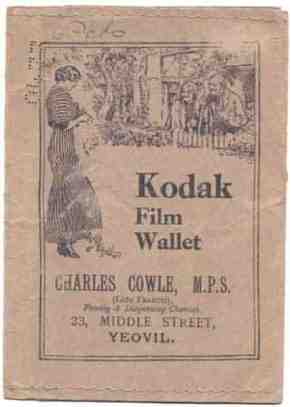 A Kodak film wallet, dating to around 1915 and featuring 'the Kodak Girl'. Charles Cowle was a chemist of Middle Street. |
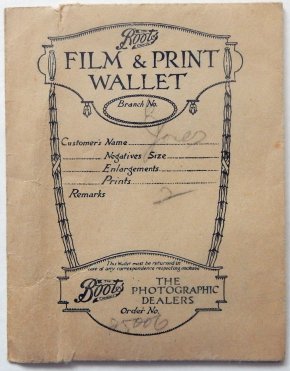 A film wallet of the 1920s by Boots the Chemist (or in this instance, Boots the Photographic Dealers). |
|
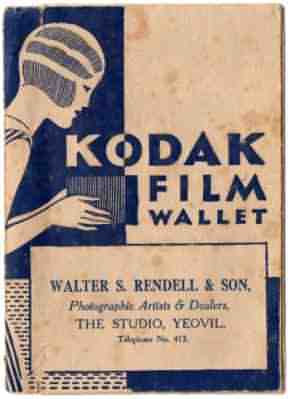 A later Kodak film wallet used by Walter Rendell & Son. This film wallet, featuring a later 'Kodak Girl', dates to the 1920s/30s. |
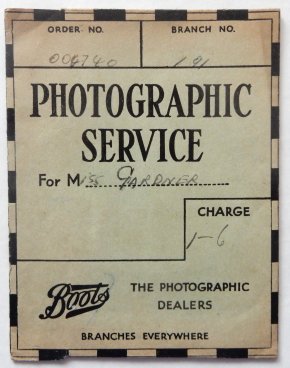 A film wallet, probably of the late 1930s, again by Boots the Photographic Dealers. |
|
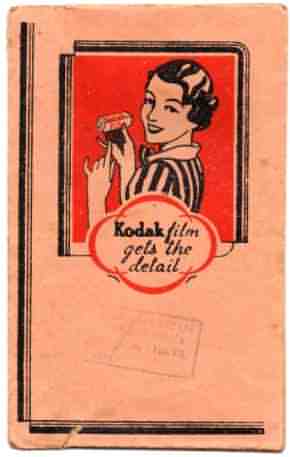 A film wallet featuring a 'Kodak Girl' of the 1950s, used by Holman & Hann, chemists of Park Road. |
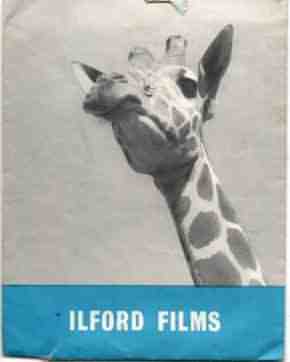 Again from the 1950s, this film wallet was used by Yeovil photographer HA 'Jack' Cooper, when his address was 42 Middle Street. |
|
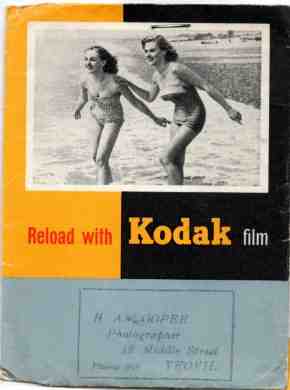 This film wallet of the late 1950s was used by HA 'Jack' Cooper. The 'Kodak Girl' is no longer a drawing, but a photograph. |
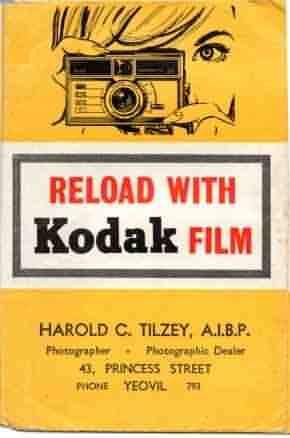 This film wallet dates to the 1960s and was used by Harold Tilzey. |
|
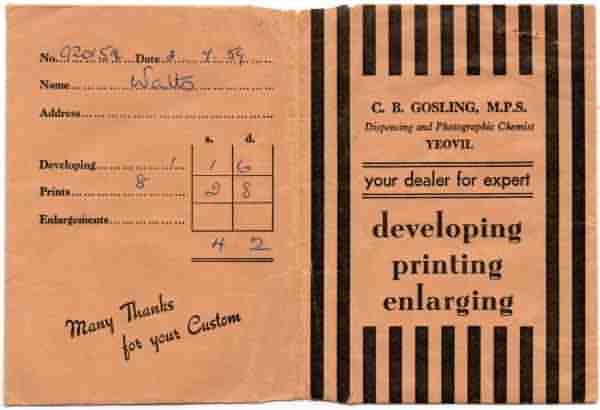 The back and front of a film wallet issued by Cecil B Gosling, 'Dispensing and photographic Chemist' of Middle Street and dated 3 July 1959. 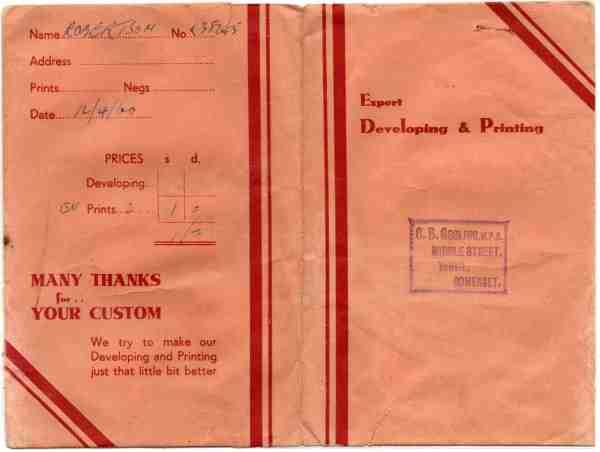 The back and front of a second film wallet by Gosling, this dated 12 April 1960. |
||
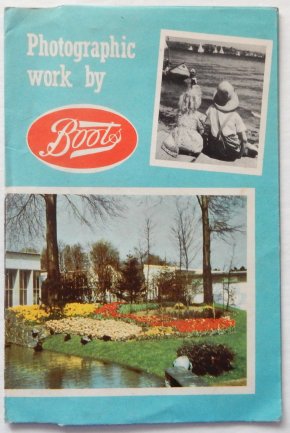 |
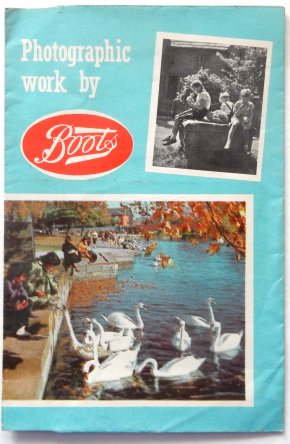 |
|
| Two wallets by Boots the Chemist from the late 1970s or early 1980s. | ||
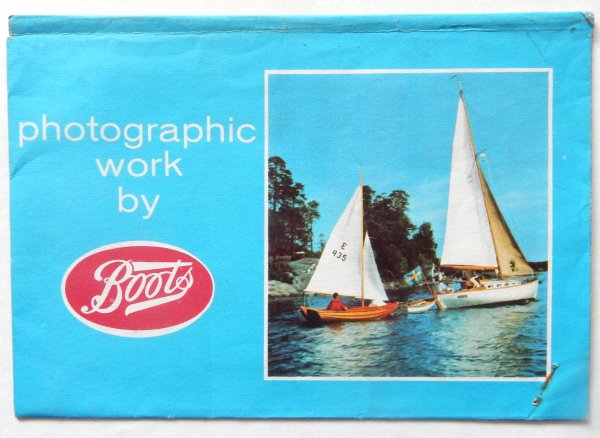 A film wallet by Boots the Chemist of the 1990s. |
||
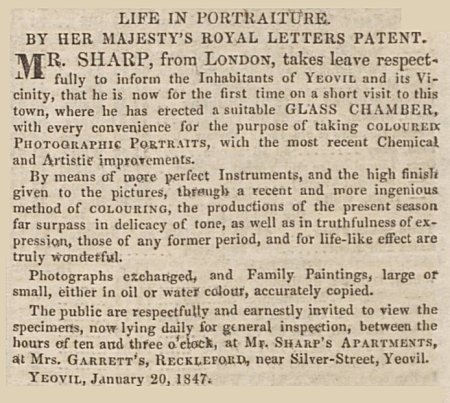
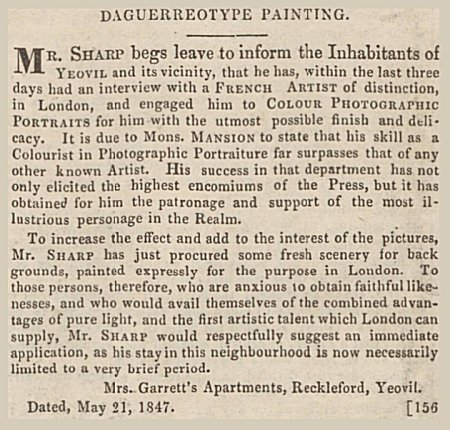
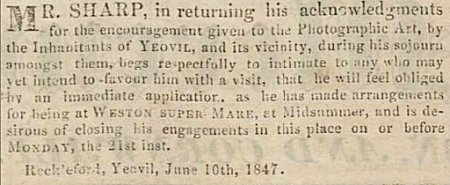
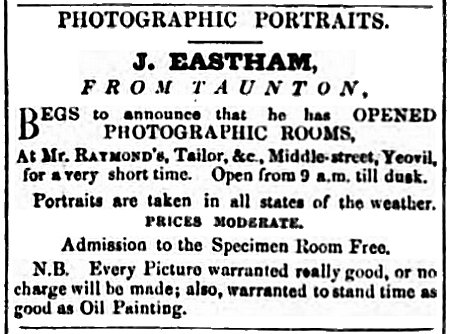
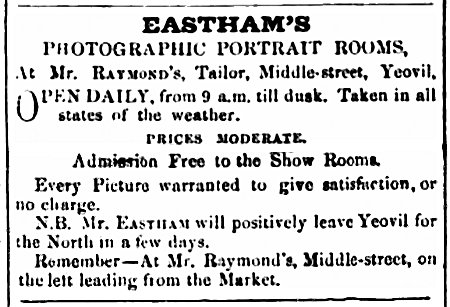
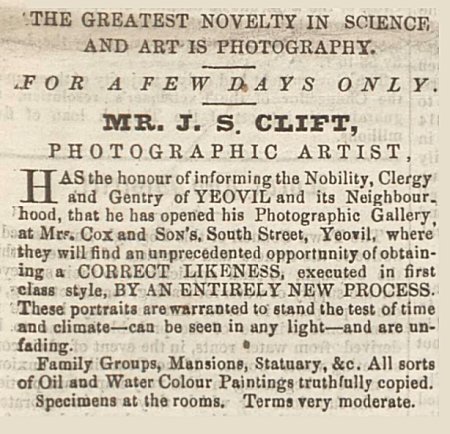
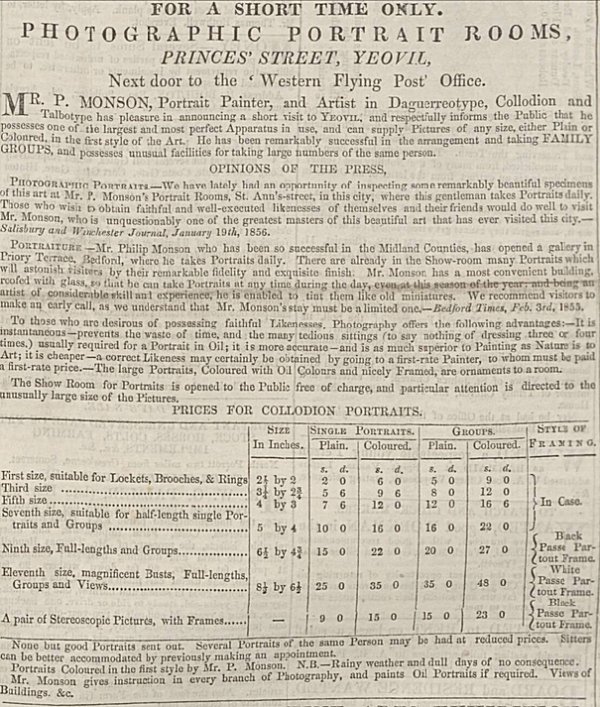
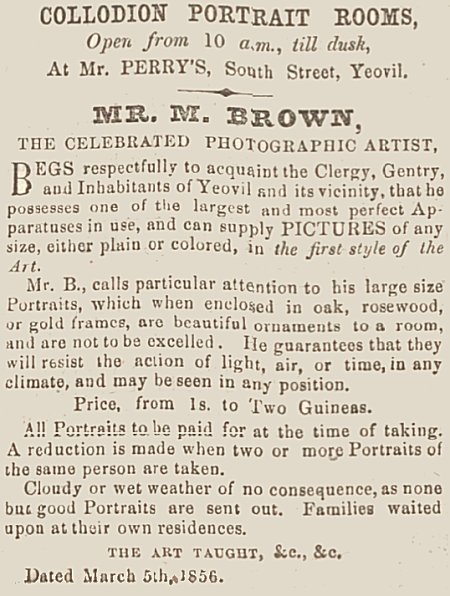
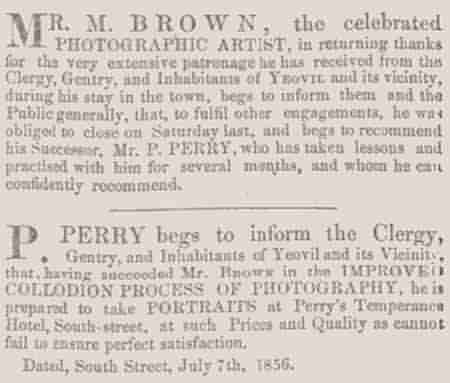
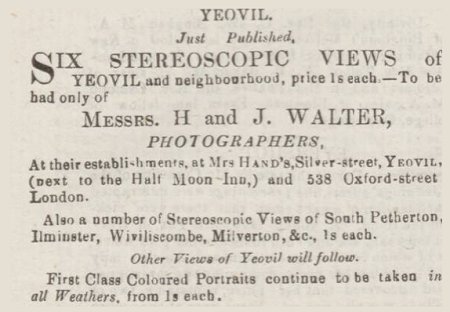
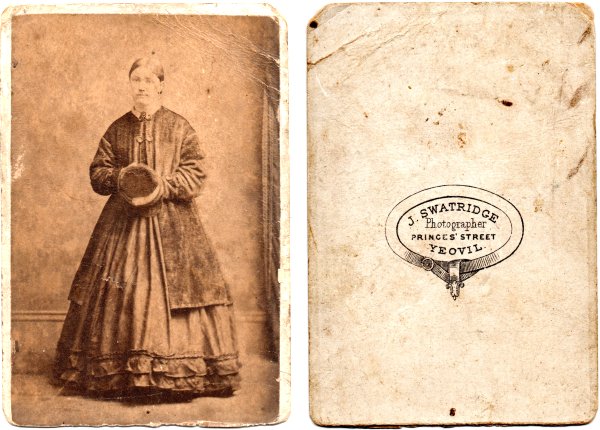
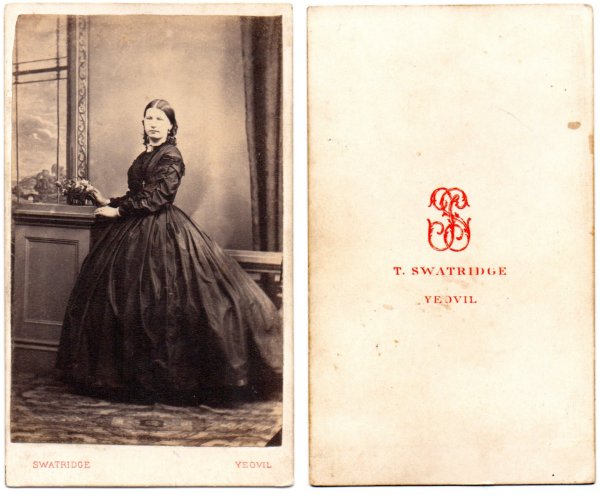
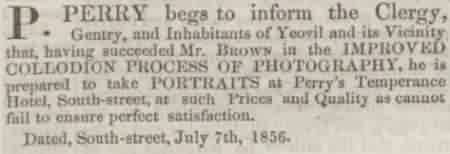
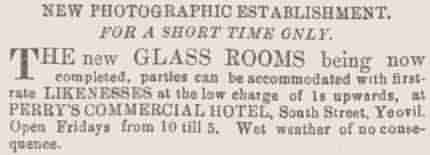
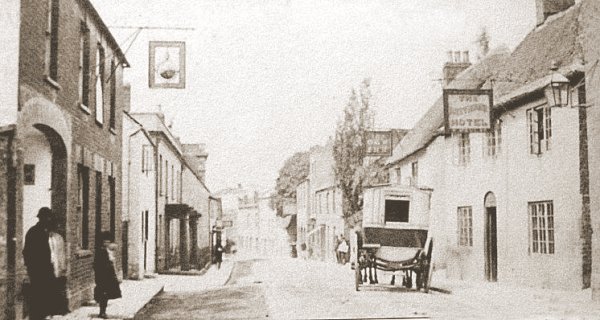
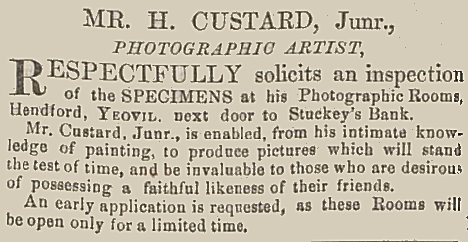
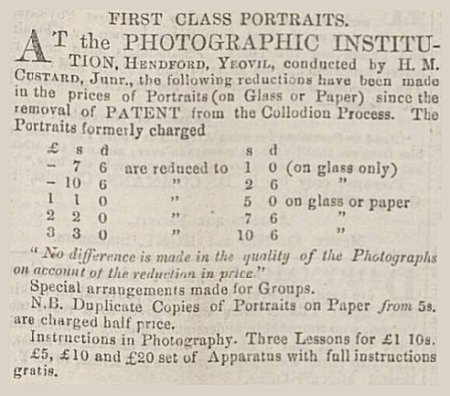

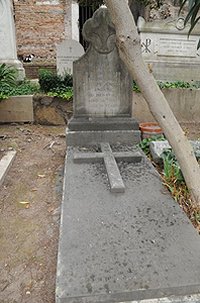 The
grave of
Henry
Marsh
Custard
Jnr.
The
grave of
Henry
Marsh
Custard
Jnr. 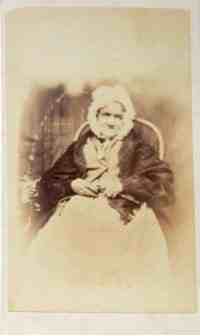 George
Bartlett
Coggan was
born in
Aller,
Somerset,
in 1816.
George
was
living
in Curry
Mallet
with his
parents
and
siblings
in the
1841
census.
George
Bartlett
Coggan was
born in
Aller,
Somerset,
in 1816.
George
was
living
in Curry
Mallet
with his
parents
and
siblings
in the
1841
census.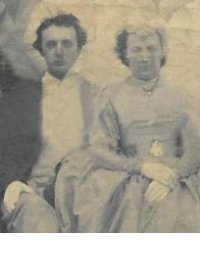 George Monck Hand (see previous)
died in
1860 and
he
had set
up a
photographic
studio
in
Silver
Street
by
converting
his
wife's
parents'
confectionery
premises
into two
- his
studio
being in
one part
and the
confectionery
business
in the
other
part.
His wife
continued
the
business
after
his
death
and the
death of
her
parents,
as noted
in the
1871
census.
Her
husband's
studio
was
apparently
taken
over by
George Thomas Rawkins
(b1839),
originally
from
Amesbury,
Wiltshire.
He
married
Clara
Chubb
during
July
1862, at
Chelsea.
The
photograph
at left
is their
wedding
photograph.
They
were to
have
nine
children.
George Monck Hand (see previous)
died in
1860 and
he
had set
up a
photographic
studio
in
Silver
Street
by
converting
his
wife's
parents'
confectionery
premises
into two
- his
studio
being in
one part
and the
confectionery
business
in the
other
part.
His wife
continued
the
business
after
his
death
and the
death of
her
parents,
as noted
in the
1871
census.
Her
husband's
studio
was
apparently
taken
over by
George Thomas Rawkins
(b1839),
originally
from
Amesbury,
Wiltshire.
He
married
Clara
Chubb
during
July
1862, at
Chelsea.
The
photograph
at left
is their
wedding
photograph.
They
were to
have
nine
children.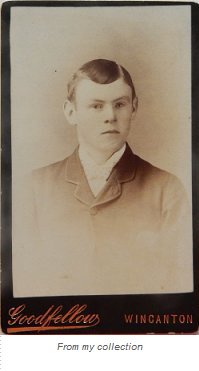 Henry
Goodfellow
was an
early
professional
photographer
in
Yeovil. He was
born in
Wincanton
in 1810
and in the
1841
census
Henry, a
lifelong
bachelor,
was
listed
as an
ironmonger.
By
1851 he
had
moved to Bourton,
near
Gillingham,
working
as a
clerk.
Henry
Goodfellow
was an
early
professional
photographer
in
Yeovil. He was
born in
Wincanton
in 1810
and in the
1841
census
Henry, a
lifelong
bachelor,
was
listed
as an
ironmonger.
By
1851 he
had
moved to Bourton,
near
Gillingham,
working
as a
clerk.
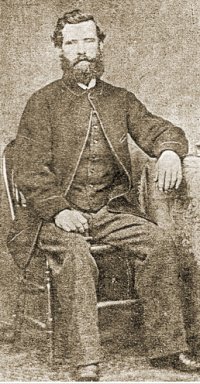
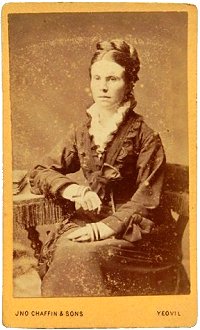
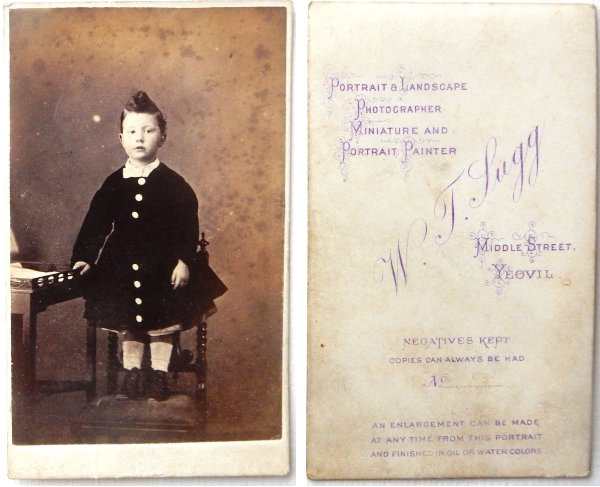
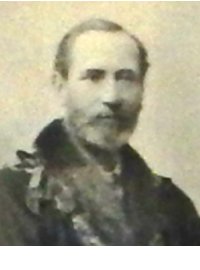 On the
retirement
of
monumental
mason
On the
retirement
of
monumental
mason
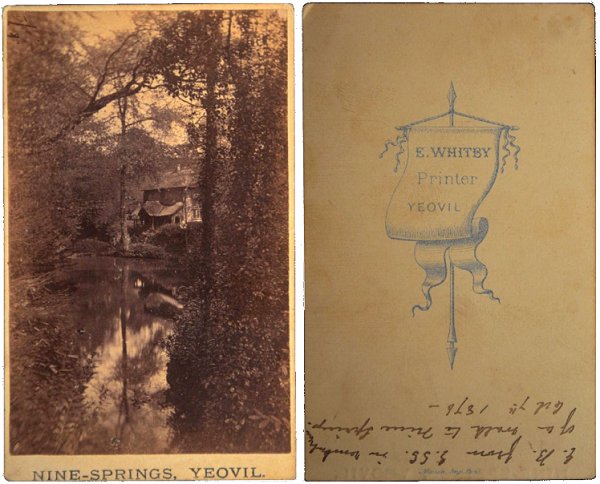
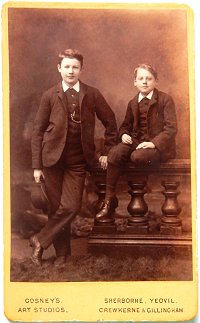
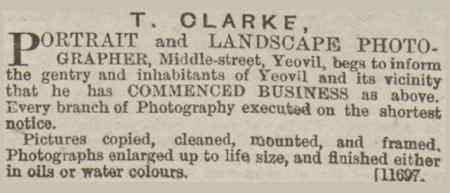
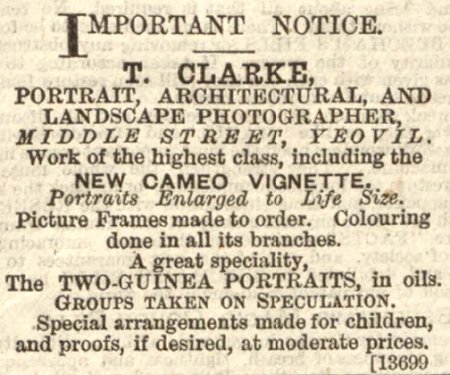
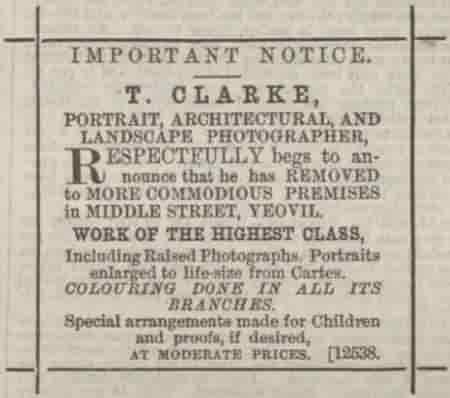
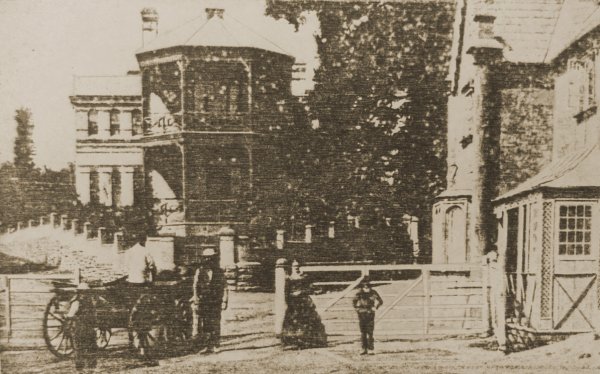
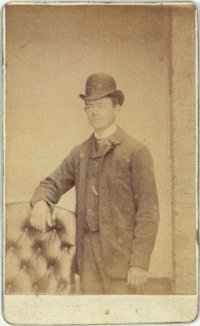 It
is
believed
that
James
Singleton
was born
in
Chillington
(between
Crewkerne
and
Chard)
in 1831.
The 1861
census
recorded
him as a
photographic
artist
at
Chillington.
In 1870
he
married
Frances
Burford
at
Dorchester
and the
census
of 1871
listed
him as a
photographer
in
Dorchester.
It
is
believed
that
James
Singleton
was born
in
Chillington
(between
Crewkerne
and
Chard)
in 1831.
The 1861
census
recorded
him as a
photographic
artist
at
Chillington.
In 1870
he
married
Frances
Burford
at
Dorchester
and the
census
of 1871
listed
him as a
photographer
in
Dorchester.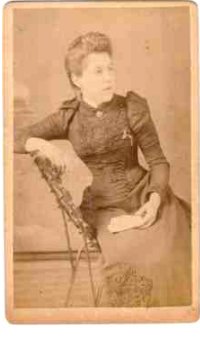 Lewis
Lee, for
a year
or two, had
a
photographic
studio
at 25
Lewis
Lee, for
a year
or two, had
a
photographic
studio
at 25
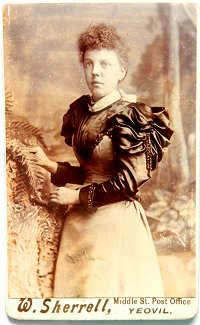
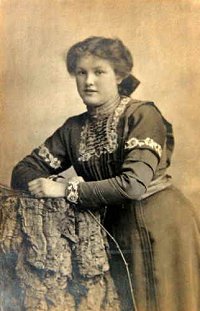
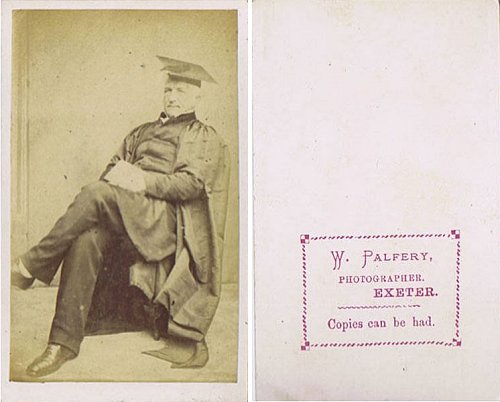
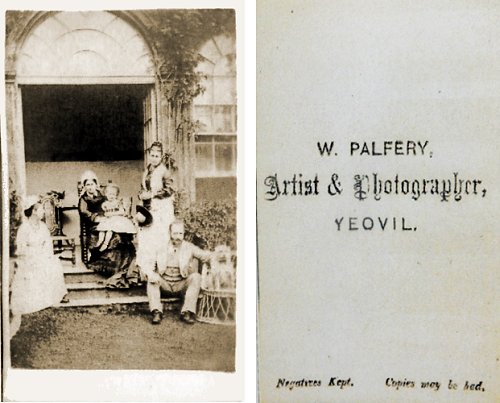
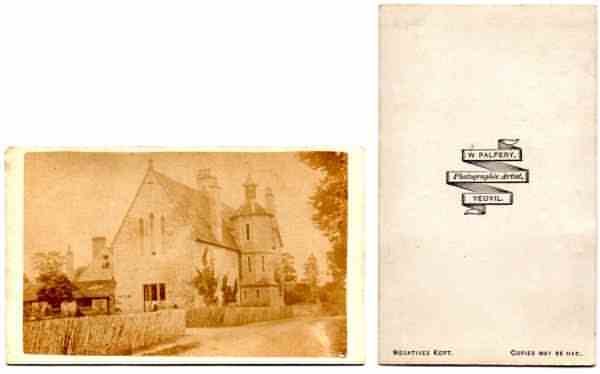
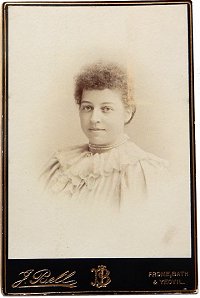
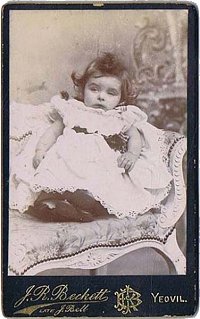
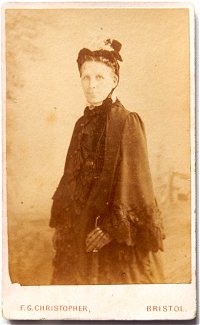
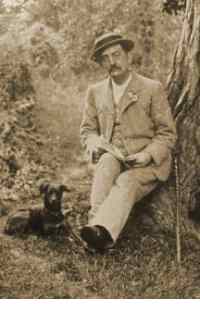 Alexander
Stuart
Macmillan
was born
in
Castle
Cary on
12
January
1870. He
was the
eldest
of the
eight
children
of
commercial
clerk
William
Macmillan
(1844-1911)
and
Emily
née
White
(1844-1937).
Macmillan
primarily
worked
as a
secretary
at the
Western
Gazette
and it
is
likely
that his
venture
into
professional
photography
was
short-lived
and
possibly
something
of a
sideline
as he
concentrated
on his
work at
the
Western
Gazette.
By 1939
he was
the
managing
director
of the
Gazette.
Alexander
Stuart
Macmillan
was born
in
Castle
Cary on
12
January
1870. He
was the
eldest
of the
eight
children
of
commercial
clerk
William
Macmillan
(1844-1911)
and
Emily
née
White
(1844-1937).
Macmillan
primarily
worked
as a
secretary
at the
Western
Gazette
and it
is
likely
that his
venture
into
professional
photography
was
short-lived
and
possibly
something
of a
sideline
as he
concentrated
on his
work at
the
Western
Gazette.
By 1939
he was
the
managing
director
of the
Gazette.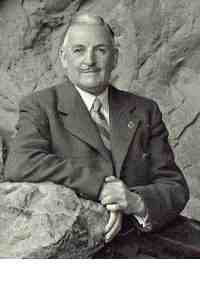 Joseph
Henry
Tatton
(photographed
at left)
was born
in 1879,
at
Hednesford,
Staffordshire,
second
of the
four
children
of
gardener
George
Tatton
(1852-1906)
and Emma
née Page
(1844-1922).
He spent
most of
his
early
life in
Staffordshire,
but in
1901 the
census
recorded
him as a
boarder
at 4
Greenhill
Terrace,
Portland,
Dorset.
22-year-old
Joseph
gave his
occupation
as a
photographer's
printer.
On 15
April
1903, at
St
John's
church,
Portland,
he
married
Elizabeth
Mary
Miller,
known as Hetty,
(1878-1966).
On his
marriage
certificate
Joseph
gave his
occupation
as a
photographer.
They
were to
have two
sons.
Joseph
Henry
Tatton
(photographed
at left)
was born
in 1879,
at
Hednesford,
Staffordshire,
second
of the
four
children
of
gardener
George
Tatton
(1852-1906)
and Emma
née Page
(1844-1922).
He spent
most of
his
early
life in
Staffordshire,
but in
1901 the
census
recorded
him as a
boarder
at 4
Greenhill
Terrace,
Portland,
Dorset.
22-year-old
Joseph
gave his
occupation
as a
photographer's
printer.
On 15
April
1903, at
St
John's
church,
Portland,
he
married
Elizabeth
Mary
Miller,
known as Hetty,
(1878-1966).
On his
marriage
certificate
Joseph
gave his
occupation
as a
photographer.
They
were to
have two
sons.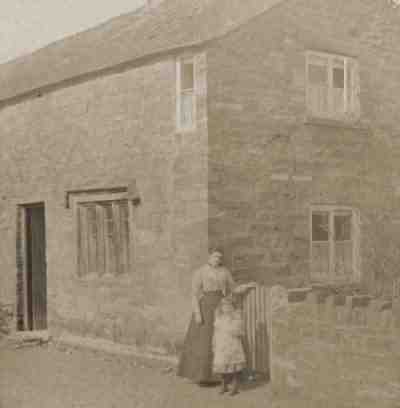
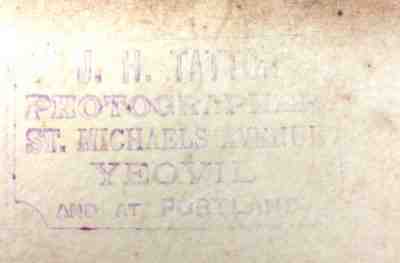
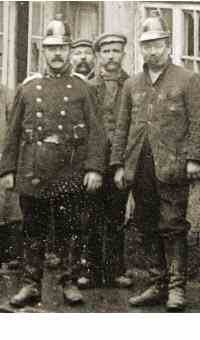 William
Alexander
Mitchelson
Ross was
born in
1883 at
St
Denys,
Hampshire,
the son
of
artist
Alexander
Mitchelson
Ross
(1816-1907) and
Maria née Biddlecombe
(b1861
- 45
years
his
junior!!).
In the
1891
census
the
family
were
listed
at 21
Dover
Street,
Southampton.
By 1906
William
Ross was
living
in
Yeovil -
the year
this
photograph
of
Yeovil
firemen
was
taken..
William
Alexander
Mitchelson
Ross was
born in
1883 at
St
Denys,
Hampshire,
the son
of
artist
Alexander
Mitchelson
Ross
(1816-1907) and
Maria née Biddlecombe
(b1861
- 45
years
his
junior!!).
In the
1891
census
the
family
were
listed
at 21
Dover
Street,
Southampton.
By 1906
William
Ross was
living
in
Yeovil -
the year
this
photograph
of
Yeovil
firemen
was
taken.. 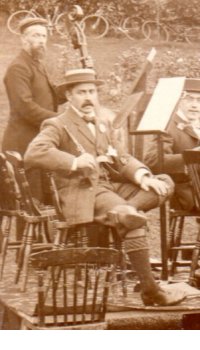 Edmund
Hugh
Rundle
was born
in the
spring
of 1877
in
Yeovil.
He was
one of
the five
children
of
saddle
maker
Edmund
Hugh
Rundle
was born
in the
spring
of 1877
in
Yeovil.
He was
one of
the five
children
of
saddle
maker
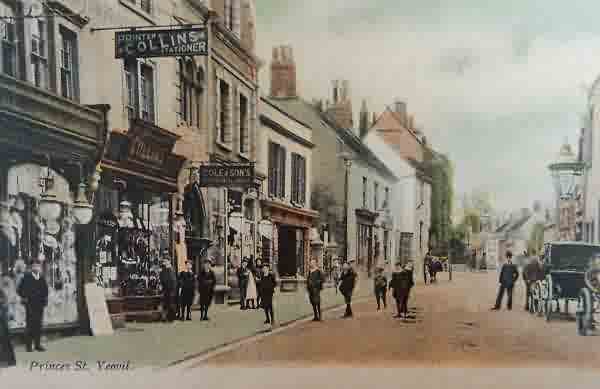
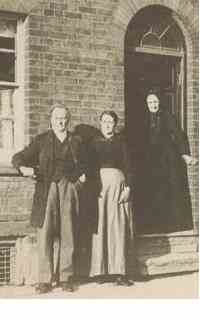 Samson Dade was born in Yeovil on 14 December 1866, the
son of
John
Dade
(1816-1897)
and Mary
Ann née
Bartlett
(1831-1908).
In 1897,
at
Yeovil,
he
married
Emily
Edmunds
(1876-1954).
Samson Dade was born in Yeovil on 14 December 1866, the
son of
John
Dade
(1816-1897)
and Mary
Ann née
Bartlett
(1831-1908).
In 1897,
at
Yeovil,
he
married
Emily
Edmunds
(1876-1954).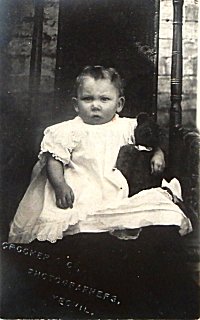
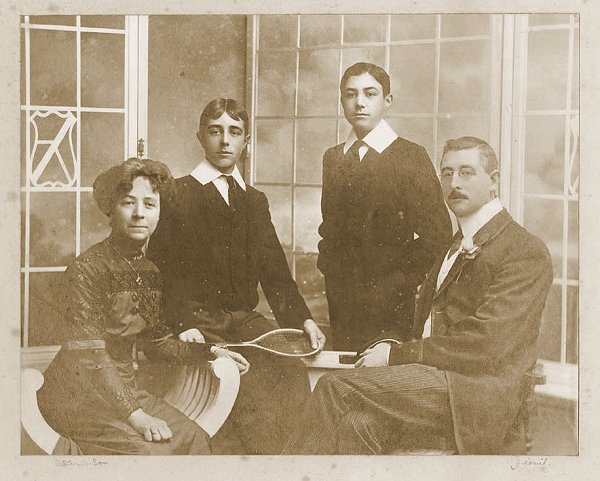
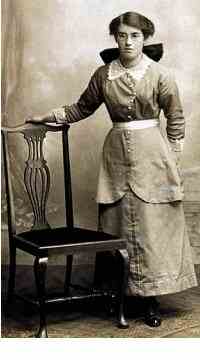 Walter
Samuel
Rendell
was born
in 1874
at
Melcombe
Regis,
Weymouth,
Dorset.
Initially
apprenticed
to his
brother
as a
draper,
by 1911
he was
working
as a
photographer's
assistant
at
Weymouth.
Walter
moved
his
family
to
Yeovil
and
set up his own
photographic
studio in 1913
at 55 Middle
Street and was
listed as a
photographer in
many trade
directories from
1914 onwards. Initially
trading as WS
Rendell and
later as WS
Rendell & Son as
his son
William Ernest joined
his father in
the business.
Walter
Samuel
Rendell
was born
in 1874
at
Melcombe
Regis,
Weymouth,
Dorset.
Initially
apprenticed
to his
brother
as a
draper,
by 1911
he was
working
as a
photographer's
assistant
at
Weymouth.
Walter
moved
his
family
to
Yeovil
and
set up his own
photographic
studio in 1913
at 55 Middle
Street and was
listed as a
photographer in
many trade
directories from
1914 onwards. Initially
trading as WS
Rendell and
later as WS
Rendell & Son as
his son
William Ernest joined
his father in
the business.